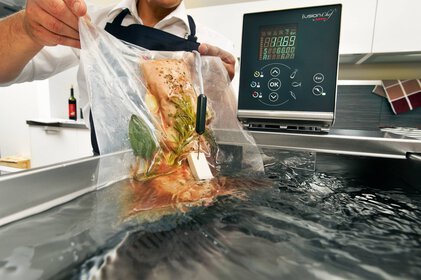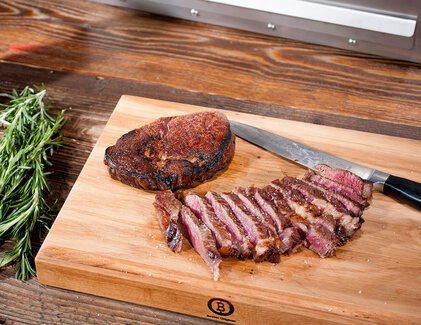Preparation tips
In the corresponding part of the section “The basics”, “Sous Vide step by step”, we have discussed the most important points. In general you can’t go wrong as long as these are observed.
Naturally there are also a number of “finer points” when it comes to Sous Vide, where there is the potential for further optimization. Whether in terms of even better flavor and visual results, the time factor, or simply in terms of avoiding common mistakes. In particular with regard to the last aspect, we have outlined a selection of practical tips in the section “Do’s and dont’s,” which make the Sous Vide procedure easy and successful right from the start.
Frozen and cooled food
Often it’s recommended that meat which has been stored in the refrigerator be brought to room temperature before being prepared. It’s said that this is the only way to ensure the best flavor. While it can be debated whether this makes sense for standard preparation methods, or makes any difference to the flavor, when it comes to the Sous Vide procedure we discourage it.
Due to slow and completely even warming in a circulating water bath, the problem that food is nice and hot on the outside but still cold on the inside, and therefore not cooked as desired, generally doesn’t occur. Another potential problem, depending on the duration and ambient temperature, is that the food may spoil quickly or at the very least decrease in quality. Therefore always place cooled food directly in the Sous Vide cooker. fusionchef devices have sufficient power reserves keep the temperature in the water bath constant and ensure that cooled food is tempered without any problem.
Things are a little different when it comes to some frozen foods. While, when it comes to soups or sauces it is irrelevant whether they are placed in the water bath frozen or defrosted, most food such as fish, meat or vegetables benefit from a gentle defrosting process and this leads to the highest possible quality.
The best and most gentle method is always slow defrosting overnight in the refrigerator. If things need to progress a little faster then another option is to defrost the vacuum bag in a cold water bath. However, with the Sous Vide procedure it is also possible to directly heat up frozen food, which is another great advantage. There is generally an astonishingly low loss of quality and even this is usually limited to a somewhat higher loss of fluid. However, this is only visible to the naked eye when directly comparing two vacuum bags (deep frozen vs. defrosted in the refrigerator).
Selection of the correct cooking temperature

This is generally very easy for the Sous Vide procedure as the appropriate core temperature for the respective food can be found in the relevant tables and recipes. fusionchef offers numerous recipes and there are naturally countless books about Sous Vide cooking available on the market, including those by the Sous Vide pioneer Heiko Antoniewicz.
The method of bath tank temperature = target core temperature has the great advantage that there is no possibility of overcooking because the temperature of the food can never rise above the water temperature in the bath tank. For most food, it doesn’t matter if it stays in the water bath for a while longer after reaching its target core temperature. This means that there is a lot of flexibility when it comes to serving time, which can be perfectly coordinated to suit the preparation time of other ingredients.
Alternatively, the bath tank temperature can also be set a few degrees above the target core temperature, which speeds up the cooking process considerably. However, to obtain an optimal result, in this case it’s important to make sure that the right moment, when the food has reached the desired core temperature, is identified and this ideal cooking point is not exceeded. Some food, for example saddle of venison, is best cooked in a bath tank with water temperature of 65 °C until the meat has a core temperature of 54 °.
To achieve this, it’s best to work with a core temperature sensor that can be connected to models in the Diamond series.
Once the set target temperature has been reached, the Diamond devices signal this acoustically and visually to ensure that the food can be taken out at the right time. This function has the added benefit that two different products can be cooked in the same bath at the same time. The water temperature can simply be set to the higher temperature (e.g. fillet steak 54 °C) and the core temperature of the other product (e.g. salmon 48 °C) adjusted using the sensor. This can then be automated for later preparation without a core temperature sensor by storing or noting the determined cooking time for the food in one of the timer memory locations. A prerequisite for this is, of course, that the thickness of the food to be cooked, as the decisive factor for the required cooking time, is approximately the same. From a practical point of view, when working with a core temperature sensor this also applies to portions of similar size or pieces that have been cut to size: If the reference piece has reached the target core temperature, then the same applies to the other portions.
After cooking: Roast aromas and serving


Not all food can be directly placed on a plate and served after Sous Vide cooking. For example, when it comes to a delicious steak nobody would be willing to do without a bit of browning and the associated roast aromas, so in this case there needs to be a little subsequent work to achieve a completely perfect result. The so-called Maillard reaction takes place in multiple stages between 140 °C and 170 °C.
It should be noted that the food is actually already fully and perfectly cooked. Significant additional heat input, which could once again increase the core temperature, is therefore not desired to avoid the food accidentally becoming overdone.
For this reason, it is important to expose the food to a high level of external heat and not, as is usually the case with roasting and grilling, to work with moderate heat over a longer time. Short but intense heat input means that only the outer layer is heated and browned while the internal temperature increase is negligible.
Perfectly suited to this tasks are high-temperature grills such as the Beefer, a flambé burner or naturally also a high-quality pan that can be heated to high temperatures and doesn't have a thin base, so that the temperature is maintained when food is placed in it. For browning in a pan, the guideline is around 20 to 30 seconds per side; using a flambé burner or the Beefer is even easier as the browning can be observed in real time and adjusted accordingly. As with standard roasting or grilling, it’s important to not overdo the browning, as black charred sections taste bitter and also don’t look particularly appetizing.
Serve warm dishes on pre-warmed plates. This slows the cool-down sequence of food and ensures that it isn’t lukewarm or bland tasting when it is served to guests, but instead arrives at the correct serving temperature. This can be all the more important for Sous Vide cooking as the preparation of some food permits lower, more gentle temperatures and further cool-down is therefore undesirable.

